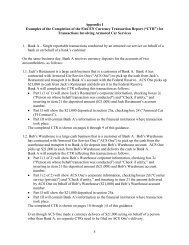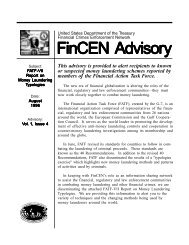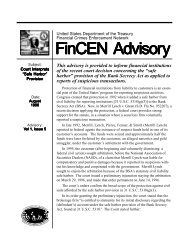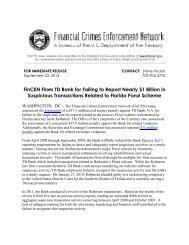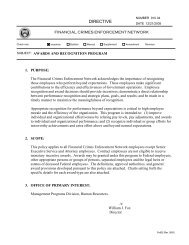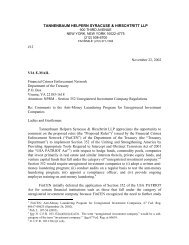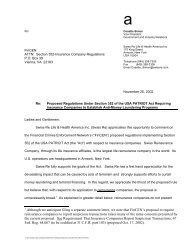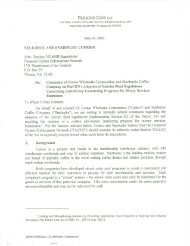The SAR Activity Review Issue 12 - FinCEN
The SAR Activity Review Issue 12 - FinCEN
The SAR Activity Review Issue 12 - FinCEN
Create successful ePaper yourself
Turn your PDF publications into a flip-book with our unique Google optimized e-Paper software.
Credit Union Cooperatives<br />
This section of <strong>The</strong> <strong>SAR</strong> <strong>Activity</strong> <strong>Review</strong> outlines findings from Suspicious <strong>Activity</strong><br />
Reports referencing credit union cooperatives that provide shared-branching<br />
services to member credit unions.<br />
Credit Union Cooperative Shared-Branching Model<br />
Credit union cooperatives operate networks that provide Electronic Funds<br />
Transfer/Automated Teller Machine/Point of Sale (EFT/ATM/POS) and sharedbranching<br />
services to the cooperatives’ member credit unions. Where applicable,<br />
cooperatives’ EFT/ATM/POS networks enable members of participating credit<br />
unions to use other participating credit unions’ ATMs without paying fees or on a<br />
reduced-fee basis. Shared branches allow members of participating credit unions<br />
to conduct transactions at either branches of the cooperative’s other participating<br />
credit unions or facilities that are managed by the cooperative itself.<br />
<strong>The</strong>re are three types of shared branches: 6<br />
• Outlet – A facility owned and staffed by a credit union where members<br />
of other credit unions, within the same cooperative network, can conduct<br />
transactions.<br />
• Stand–Alone – A facility owned and staffed by a credit union cooperative,<br />
where members of participating credit unions can conduct transactions.<br />
• Partnership Outlet – A facility owned by a credit union or group of credit<br />
unions and staffed by employees of the cooperative, where members of<br />
participating credit unions can conduct transactions.<br />
Credit unions belonging to shared-branching networks fall into two categories:<br />
• <strong>Issue</strong>r – Credit unions that allow their members to conduct account<br />
transactions, transfers, or payments at other outlets, partnership outlets,<br />
and stand-alones within the same shared–branching network.<br />
• Acquirer (<strong>Issue</strong>r/Acquirer) – <strong>Issue</strong>rs that serve as outlets by accepting and<br />
processing transactions from members of other credit unions within the same<br />
shared–branching network.<br />
In a given transaction, the issuing credit union pays a fee to the acquiring credit<br />
union. If the transaction occurs at a shared-branching facility that is operated<br />
by the cooperative, the issuing credit union pays a fee to the cooperative. <strong>The</strong><br />
cooperative annually distributes its income collected from fees to its stockholders.<br />
Credit union cooperative shareholders can be credit unions, corporate/industrial<br />
credit unions, state credit union leagues, or other credit union service organizations.<br />
6 Swedberg, Jamie. “Share and Share Alike.” Credit Union Management. January 2006. pg. 38; and<br />
Dernovsek, Darla. “Shared Branching Takes Root.” Credit Union Magazine. November 2005. pp. 44-47.<br />
1



